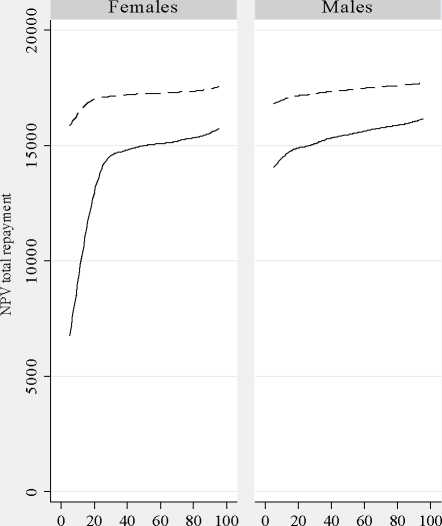and the addition of grants and bursaries are taken into account, for all students from
poor backgrounds, the total payments required on graduation will actually be lower
under the new system than under the old system. The opposite is the case for students
from richer backgrounds, the majority of whom would repay more under the new
system, with the exception of females from the bottom 20% of the graduate earnings
distribution.
Figure . Distributional effects of new system compared to old system of HE
funding: net effects of i) increased government debt, ii) reforms to loan system,
and iii) reduction in requirement for private debts
Poorest students Poorest students

Percentile of the lifetime earnings distribution
New system, £18,340 govt debt
Pre-reform, £12,350 govt debt + £5,990 private debt, poorest students
Richest students Richest students

Percentile of the lifetime earnings distribution
New system, £18,340 govt debt
Pre-refcιm, £9,265 govt debt + £4,925 private debt, richest students
So although graduates in general will be asked to contribute more to the costs of their
education under the new system, the ones who as students were poorest will end up
repaying less in loans than prior to the reforms. This is due to the combination of two
factors: first, the fact that they would not have to borrow as much money privately
under the new system, and second, the two changes to the loan repayment conditions
22
More intriguing information
1. The name is absent2. Banking Supervision in Integrated Financial Markets: Implications for the EU
3. New Evidence on the Puzzles. Results from Agnostic Identification on Monetary Policy and Exchange Rates.
4. The name is absent
5. Testing the Information Matrix Equality with Robust Estimators
6. ANTI-COMPETITIVE FINANCIAL CONTRACTING: THE DESIGN OF FINANCIAL CLAIMS.
7. The name is absent
8. A THEORETICAL FRAMEWORK FOR EVALUATING SOCIAL WELFARE EFFECTS OF NEW AGRICULTURAL TECHNOLOGY
9. I nnovative Surgical Technique in the Management of Vallecular Cyst
10. MANAGEMENT PRACTICES ON VIRGINIA DAIRY FARMS